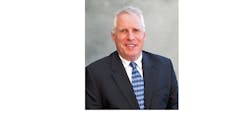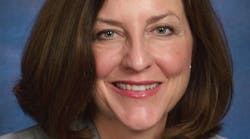With the help of a savvy management consultant, a small-town distributor is proving it can change with the times and keep up with the big boys on the trek into the 21st Century.
Three years into a five-year plan to re-engineer and refocus his company for the future, Eddie Strickland, president of Craven Electric Supply Co., Inc., New Bern, N.C., feels at times as if he has turned his company inside-out. The trick, he says with a grin, is not turning it upside-down in the process.
So far, Craven Electric is not only right-side-up, it's stronger than ever. Sales were at $7.5 million at the end of 1995 when Craven management began planning the changes they wanted to implement. By the end of 1997 sales had rocketed to over $10 million-an increase of more than 33% in two years-and only about half of the proposed changes had been put into place. The strategic plan, called Craven 2000, is the road map for these changes, and Strickland says it's the company's process for getting from 1995 to the year 2000.
"The new Craven paradigm is a dynamic, focused, fast-paced organization. The old paradigm was status quo. Just status quo," says Strickland. Back when Eddie's father began the business in 1965, Craven was basically a construction-oriented house, with some MRO business, according to Strickland. "In those days there was a market, you opened your doors, and stocked some inventory," he says. "I don't mean to oversimplify it, but it certainly wasn't as complicated as it is today."
Strickland picked up the scent of change in the wind in the late '80s when he began to see alternate channels of distribution popping up in the industry. "We started noticing more competition, and the competition that we were seeing seemed to be more fierce in a lot of ways," he says. "Margins were being squeezed. The big-box guys, the Graingers, the Graybars, were coming down with low-ball numbers on hot items, and they were developing the perception that they were the least-expensive source."
Through networking within Affiliated Distributors (A-D), Wayne, Pa., he began to realize where some of the larger companies had the advantage--they had a lower cost of doing business. "It seemed like no matter what we did, we couldn't get the bottom line up," says Strickland. "Expenses kept creeping up, and margins kept creeping down. It doesn't take a financial wizard to figure outthat after awhile they're going to meet in the middle."
Strickland says that back in the '70s and early '80s the company was able to net 4% or 5% income before taxes. "But it was getting to the point where we were down in the onesie, twosie range," he says. "We just decided that was not acceptable for the risk we take and the amount of work we have to do to get our products and services out the door." Something needed to change. Strickland and his brother Phil, who is vice president of operations, decided they had three options: Get out of the business, downsize to the point where they could get the profitability back up, or upsize the business to where they could afford, through economies of scale, the people to build better customer relationships and the systems required to get transaction costs down. They could go quietly join some large conglomerate or chain, or they could themselves become acquirers and engines of growth. Craven made the decision not to go quietly.
Strickland says that, while networking with other members, he did a lot of listening the first few years. "I started talking to people who were experiencing good growth," he says. "I thought, there's really nothing that much different about their marketing area. It's bigger. It's in a different part of the country, but they've got the same problems and the same opportunities. What are we doing wrong? What are we doing right?"
Strickland was sure there was a way to get Craven back on a growth track. He and the other managers had a lot of good ideas; they just needed a plan. "I had thought about looking into a consultant," he says. "But I'm looking around at Arthur Andersen and those guys, and I'm thinking, 'Who can afford them?' I mean, you talk to some business owners about consultants and they'll just hee-haw- they'll just laugh at you and say, 'Consultants?'
"Well, I looked at a lot of the larger distributorships, and they could afford to have marketing people-executive management people who could help with the strategic plans of the business. I just became thoroughly convinced that we needed to hire a consultant on a part-time basis to help us remold, refocus and get the company headed in the right direction." He turned to Ed Lay, Jr., president and managing director of Distribution Resources, New York, N.Y.
Strickland knew Lay through A-D. "I knew about Ed's background and experience in the industry," Strickland says. "Once we talked, I could see this guy wasn't just a B.S. artist. He knew what was going on in this business, and I realized I needed some help to pull this together. I was too busy fighting fires every day."
One of the first things Lay did was survey Craven management. Lay says the survey showed that Eddie and his managers knew what the problems and challenges were for Craven, they just didn't know how to attack them, or what priorities to assign to each problem.
"When they looked at those (survey) results objectively, there were some realities that came forth that had to be accepted," says Lay. Some of those realities included having to hire additional senior management personnel-an expensive investment-and having to replace a 10-year-old computer system that was about to die on them-another expensive investment. "That's when you're at a decision point," says Lay. And that decision, he says, must be to either downsize and not make further investments in the company, or to commit to investing in growth and change. If the decision is to grow, Lay says it's critical to formulate a well-researched, step-by-step plan to map out how that growth is to be accomplished.
A plan, he says, creates a framework for decision support and for measuring, monitoring and evaluating. "A strategic plan is a road map," he says. "It keeps the company focused and within some kind of parameters. There are checkpoints, benchmarks and evaluation criteria that let you know where you are. There's a very famous quote in Lewis Carroll's Alice in Wonderland where Alice meets the Mad Hatter, and he says, 'Where are you?' and Alice says, 'I'm lost. I'm not sure where I'm going.' And so the Hatter says, 'Then any direction will do.'"
Dissatisfied with just drifting along in any direction, Eddie, his brother Phil and other key management personnel set to work to formulate a plan with the Lay's help. By January 1996 they had come up with a strategic plan that included seven performance improvement tracks: information management systems, sales and marketing, personnel development and training, total quality management (TQM), communications, profitability enhancement and vendor relations.
Vendor conferences were the first thing implemented. "The goal of the vendor conferences was relationship-building and identifying important things we needed to do together to grow our businesses," says Strickland. The logic was that if the vendors became part of the team, if they could be sold on the planning process and its benefits and could see the likelihood that their business would increase, Craven's business would increase also. So they identified the top 12 vendors. "Generally, you see that 10 or 15 vendors constitute 70% or 80% of your business," says Strickland. "It made sense to get them together in an environment that facilitated joint business development, marketing, planning, advertising and promotion--everything that would influence a vendor's business positively."
Strickland requires that either a regional sales manager or corporate person attend the meeting along with the local rep, because he doesn't want the conference to turn into a "glorified sales meeting." Before each conference, vendors get an invitation letter that states the goals, what they need to bring to be prepared, and the agenda. Strickland makes sure his managers and salespeople are prepared with their own specific issues to address, and he emphasizes before each conference that it is not to be turned into a gripe session.
Strickland explains that the purpose of this meeting is for the vendor's corporate or regional business-development person and local rep to have an audience, in one day, with all of Craven's key business-development people, in a rotating schedule. "With a focused agenda to talk about, you can get a tremendous amount of work done in a very short amount of time. That's why it just really blows my mind when some guy says, 'Well, I just can't make this. I've got conflicts.' I mean, what a missed opportunity for a vendor."
Lay says some vendors in their second year of vendor conferences are seeing 30%-40% increases in business with Craven; some vendors have doubled their business. "The vendor has a tremendous stake in this planning process because it serves their interest," he says. "Historically, profit in the wholesaling industry has been a dirty word because everybody's been price-driven. The fact is, companies that don't make enough profit are not going to have the funds to make the investments required to achieve the service levels customers are going to demand."
To achieve those profits and levels of service, Lay insists there has to be a dimensional-matrix approach to planning. By that he means that the impact each planned change will make throughout every department in the company needs to be taken into account. He compares this type of planning to a Rubrik's Cube. Each twist of the cube to change the pattern of squares on one side changes the pattern on every other side of the cube as well. Before you make a twist to change one side, you need to decide if those collateral changes on the other sides will aid or hinder you in your ultimate goal. By looking at change in this way, he says, every operational component is taken into account and made to come together and work as a team.
Next they did a complete personnel audit, looking at roles and responsibilities. Strickland and Lay analyzed the present personnel needs of the company as well as what would be needed to move from the old paradigm to the new one.
"New people and new systems are investments that scare small and mid-sized companies because they're not sure at all what the outcome's going to be." says Lay. "But with a strategicplan, you've got the support to make intelligent decisions about all kinds of things, from equipment purchases, to people, and so on. That's what the planning process is about. To create decision support in all areas."
The personnel audit showed that Craven needed some senior management people, people who could come in, hit the ground running and make a difference very quickly. Someone who knew the market, knew the customers. And those are not easy people to find.
"It's hard to recruit somebody who's working for another company, because if they're worth their salt, they're being taken care of," Strickland says. "But some situations presented themselves where other companies were downsizing or lost some large contracts and were having to scale down their operation. In some cases, the people they were putting on the street were the people we had wanted to talk to. You know, there's an old saying that even a blind hog finds an acorn every once in awhile. But you've got to be rootin' around!"
Billie Elliott, Craven's regional vice president for the Kinston and Washington, N.C., areas, was one of those people. Elliott had almost 22 years of experience with a larger distributor in the North Carolina market. When he came to Craven Electric, his primary focus was to enhance the visibility of Craven, which was primarily perceived as a residential distributor. To target a wider range of business, during the planning stage the business was divided into three different marketing segments: residential lighting; residential and commercial construction, which Strickland says has always been the backbone of Craven Electric; and industrial and institutional MRO business.
"We wanted to change some of that residential focus toward more commercial and industrial business," Elliott says. "I was able to bring a couple of guys on board with quite a bit of experience, and we put them in strategic places to help enhance our growth and visibility in that marketplace."
Elliott and Bill Carter, regional vice president for the New Bern, Morehead City and Jacksonville, N.C., area, were particularly interested in seeing experienced salespeople placed in sales areas they understood and were comfortable with, and making sure that the salespeople were focused. To help the salespeople zero in on the most profitable customers, they started evaluating every account on a quarterly basis.
The quarterly evaluations gave them three-month reports on what a customer was or was not doing, and what the account salesperson was or was not doing. "Within six months we had an account history" says Elliott, explaining that the histories gave them a way to measure each account's activity.
Bill Carter, who has been with Craven for almost 20 years, says that when he first came to Craven, the salespeople had no weekly plan, no reporting method. He told them they would have to start planning and reporting in order to get a paycheck. Carter requires that a written plan for the coming week, plus a written report on the preceding week be turned in every Monday morning. He pulls no punches when it comes to these reports. "These documents are part of your job," he tells them. "And you will turn them in on time if you want a paycheck. It's cut and dried."
Carter tells his salespeople not to waste the company's money on time spent running down the road waving at people. "When you visit a customer, you need to have a purpose for talking to the customer," he says. The planning seems to be working. Carter says sales are way up, and so far, only one guy has missed a paycheck.
As is typical of a small distributor like Craven, Eddie Strickland says the Craven branches used to be more like convenience stores or inventory centers. "Our branch managers were pretty much just figureheads, or administrative-type people," he says. "The new paradigm for the Craven Electric branches is that branch managers are going to be business development managers. We're pushing changes through the organization with this new regimented, dimensional business plan that forces interaction between everybody and shows them where they're dependent and where they need to work with each other.
"Typically management and maybe some smart salespeople think about planning," he says. "But we're going to get it right down to the receiving clerks and the counter guys. Everybody will have their part."
Planning with a purpose included fine-tuning a large and geographically widespread customer base: "We fired some customers," says Carter. "If you look at it from a cost basis and do an analysis, even though a guy may spend $50,000 a year with us, he might be costing us $20,000. Why? He brings half his stuff back. He's got 8,000 invoices a month. He buys one thing at a time. He special orders stuff that won't work. He's hard to do business with, and he doesn't pay his bills on time. We don't really need him." Carter says the acid test is to ask the question, "Is this a customer you'd like your competition to have?" If the answer is yes, Carter says tell the salesman to quit calling on him. Period. "It gives you more valuable time to spend in the right place with the right customer."
Spending time with the right customers has resulted in higher margins per employee, and Strickland says margins are the thing you need to look at-profit dollars. An employee can generate phenomenal sales numbers for a company and still not be generating a lot of profit. "Nobody wants to tell you what his or her employees' gross-margin contribution is as a percentage," he says. "They'll tell you sales-per-employee, but they never talk about gross-margin contribution per employee." He says it doesn't make sense to sacrifice profitability just to get a higher market share.
Strickland says looking strictly at sales volume is a mistake, and his top salesman is a good example. "He had about 75 accounts, and we cut it down to 50. Boy, he yelled, and he screamed, and he kicked, said he wasn't going to be able to buy clothes for his kids for school. We said, 'Yes you are. You'll do more business. You'll make more money. Now you've got time to focus on the good accounts. And out of those 50 we want 10 of them, only 10, to be your key accounts.' We started making this guy focus. We made him hungry. And lo and behold, he made more money than he ever made before. He made more sales. He made more gross margin."
Facilitating sales has been key in the Craven 2000 plan. Early in the planning stages, Eddie, Phil and the other managers decided they wanted to double their business in five years. To accomplish such an ambitious goal, they first did a formal market analysis.
Strickland says they used formulas from EW's "Market Planning Guide," NAED's PAR report and others. They calculated the market share for their area based on the number of electrical contractor employees, each being worth so-many dollars. Because the data they used were national averages, they knew there would be some fluctuation. But eventually they came up with what they thought their market was worth. Strickland says he wouldn't call eastern North Carolina a boom economy, but he says it's healthy. So with normal growth of 5% or 6% annually, and by increasing their market share, they thought they should be able to achieve annual growth of 15%, which would double their sales in five years.
"At first I said we can't do that," says Strickland. "And Ed (Lay) said, 'Yes you can. It'll get easier.' And I said, 'No, it'll get harder, because you're trying to get 15 on top of 15, so by the third year, we're just going to be going nuts.' Well, guess what? The first year we hit 22%, the second year 15%."
Lay explains this type of growth is possible because as you progress, you lay down new foundation. "You don't keep basing your projections on the original people and capabilities," he says. "Each year you added new systems, new people, and new customer relationships. Once you have that foundation in place, success and growth fuels itself. If you have growth, you can get interest in your company, get new customers. No one is interested in a company in decline."
To achieve the fastest growth possible in the early stages of the plan, Eddie, Ed Lay, Bill Carter and Billie Elliott decided that it was faster and more economical to get new business out of the existing customer base, than to grow via new customers. "It's easier to get business from someone you're already doing business with because you're a member," Strickland says. "You're already a supplier. It's hard to go out there and get somebody to dub you as one of their suppliers if they've already got suppliers."
Ed Lay says statistical studies show opening a new account costs between 15 and 20 times the amount of time and money you would spend increasing your business by a comparable amount with an existing customer. "There's a huge difference in cost," he says. "So, since every customer has more than one supplier, the question is, are you getting your fair share of that customer's business?"
Strickland is seeing high motivation in his employees to get that fair share of business, and he thinks it's because they are seeing positive steps being taken, whereas before there was just a lot of talk about doing things. But Strickland hasn't forced any of the changes. He has been very careful to build consensus throughout the process so that everybody understands the goal of the company. He says team-building has caused an overall shift in attitude, and the committees and teams have helped bring Craven's people closer. "Now they're working together on problems and solutions, rather than sitting there saying, 'Ah hell, nothings going to happen. I could call headquarters, but nothing's going to happen,'" says Strickland.
Nowhere is this teamwork approach more apparent than within the company's operations staff. Phil Strickland heads up Craven's SWIM Team-and these team members are anything but all wet! SWIM stands for Superior Warehouse Inventory Management, and it was created as part of the plan to strengthen inventory control. SWIM Team members are all the people who deal in inventory every day: the purchasing agents, the stock-receipt guys who put up stock, the order pickers, even the salespeople who key orders into the computer. Each has a section in the warehouse and is the "owner" of the inventory in that section-they are responsible for keeping it stacked neatly, and when it comes time to cycle-count, it's also their section to count.
In addition to being motivated by a healthy competition to keep their own sections as neat or neater than the other sections, according to Phil, the employees understand that it's to their advantage if inventory is correctly counted and in its proper spot. "Guys on the counter make commission on sales, and they don't want to walk into the back and find that the product they said is in stock is missing or has been miscounted," he says. "Same thing with the guys in the back. They get paid for line items that they pull or put up, so they want that stock to be correct. They get 10 cents a line if it's right, but they lose $10 a line when it's wrong. So the mindset is 'Not only do I want all my inventory to be right, I don't any inventory anywhere to be wrong.'"
Inventory discrepancies are a common problem in any warehouse, but Phil says that since the SWIM Team implementation, overall operations efficiency is up 20% and accuracy is up to about 97.5%. The team's goal is 99.75% accuracy. Plus, there are plans to further streamline the system for more efficiency by adding bar coding and implementing paperless warehouse techniques.
Phil says it makes sense to invest in efficient warehousing processes because good inventory counts have a trickle-down effect in the company. Not only does an orderly and accurate inventory look better and make happier warehouse and purchasing employees, it makes happier customers because their orders can be filled as promised. That makes better customer relations and easier sales.
Convinced now that Ed Lay was right about being able to keep up with the projected growth rate of the Craven 2000 plan, Eddie Strickland is already looking beyond the first five years of change. "We will have to expand our trading area,and that will be through acquisitions, or maybe moving into other areas," he says. "But there'll come a time when we'll just level off in the market share that we are able to achieve. Then we'll have to rely on whatever growth occurs in the market, find a way to increase our share of that, and try not to cop that old status-quo attitude."
1996 sales: $8.9 million, all electrical products Top executive: Eddie Strickland, president Employees: 51 Locations: All offices are in eastern North Carolina-New Bern (main office), Kinston, Washington, Jacksonville and Morehead City ( Craven Lighting Center also located here). Customer base: Roughly 30% residential construction, 30% commercial/institutional construction, 30% MRO, 10% showroom lighting and retail. Founded: 1965 by Edward A. Strickland, Sr. Philosophy: Achieve excellence in customer satisfaction; be the supplier of choice for customers and vendors; and be the employer of choice for those who wish to make the electrical distribution business their career in the eastern Carolina market.
You can use some of the ideas that drive the Craven 2000 strategic plan in your company. Here's a 10-step program that you can use to reinvent your business:
1. Admit there's a problem and that you need some help.
2. Network aggressively with key industry figures. Find out what's working, or not working, for them.
3. Hire a consultant who has practical distributor experience, one with whom you can attain a good "comfort level."
4. Work with the consultant to outline a strategic plan for moving the company from its present position to where you want it to be in three years, five years, etc.
5. Develop a consensus-building process to get everyone in the organization behind the plan. This will help overcome the resistance to change, a natural part of human nature.
6. Identify key performance improvement tracks. Name a "champion" in each of those areas who understands the company's new goals and who can be responsible for piloting changes.
7. Establish benchmarks and milestones to measure performance and progress.
8. Identify the resources you need to accomplish the goals in the time specified.
9. Get financing, if necessary, to procure the resources. The consultant can often help put together a business plan to present to your current financial institution, or help you find alternative financing.
10. Implementation. You have the plan and the proper tools. Go for it-then be patient. Strong growth and positive change don't happen overnight.






